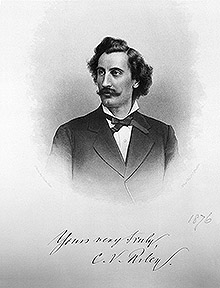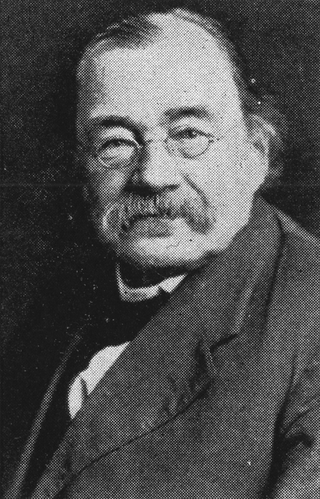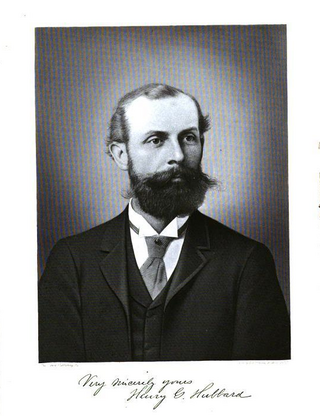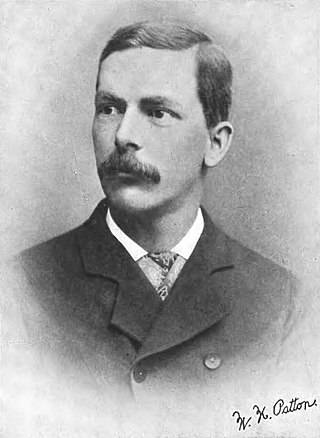Related Research Articles

Amasa Leland Stanford was an American attorney, industrialist, philanthropist, and Republican Party politician from California. He served as the 8th Governor of California from 1862 to 1863 and represented the state in the United States Senate from 1885 until his death in 1893. He and his wife Jane founded Stanford University, named after their late son.

The American Railway Union (ARU) was briefly among the largest labor unions of its time and one of the first industrial unions in the United States. Launched at a meeting held in Chicago in February 1893, the ARU won an early victory in a strike on the Great Northern Railroad in the summer of 1894. This successful strike was followed by the bitter 1894 Pullman Strike in which government troops and the power of the judiciary were enlisted against the ARU, ending with the jailing of the union's leadership for six months in 1895 and effectively crushing the organization. The group's blacklisted and dispirited remnants finally disbanded the organization via amalgamation into the Social Democracy of America (SDA) at its founding convention in June 1897.

John Obadiah Westwood was an English entomologist and archaeologist also noted for his artistic talents. He published several illustrated works on insects and antiquities. He was among the first entomologists with an academic position at Oxford University. He was a natural theologian, staunchly anti-Darwinian, and sometimes adopted a quinarian viewpoint. Although he never travelled widely, he described species from around the world on the basis of specimens, especially of the larger, curious, and colourful species, obtained by naturalists and collectors in England.

John Lawrence LeConte MD was an American entomologist, responsible for naming and describing approximately half of the insect taxa known in the United States during his lifetime, including some 5,000 species of beetles. He was recognized as the foremost authority on North American beetles during his career, and has been described as "the father of American beetle study".

Hermann August Hagen was a German entomologist who specialised in Neuroptera and Odonata. He had established himself as one of Europe's preeminent entomologists by 1867 when he accepted a position at Harvard University to curate the Museum of Comparative Zoology. In 1870 he became the first entomologist in the United States to hold the formal title, Professor of Entomology.

The Royal Entomological Society is devoted to the study of insects. Its aims are to disseminate information about insects and improving communication between entomologists.

Karl Hermann Amandus Schwarz was a German mathematician, known for his work in complex analysis.

Charles Valentine Riley was a British-born American entomologist and artist. He was one of the first individuals to use biological pest control and authored over 2,400 publications. He convinced Congress to create the United States Entomological Commission and was among the founders of the American Association of Economic Entomologists.

Leland Ossian Howard was a pioneer American entomologist who worked in the US Department of Agriculture. Serving as the chief of the bureau of entomology, a successor to C.V. Riley, he helped establish economic entomology as a profession in the United States and strengthened research activities, helping establish laws to prevent the introduction of agricultural pests. He was a specialist on the parasitic wasp family Chalcididae, and contributed to the introduction of biological control agents for pest management. Howard also took an interest in medical entomology.

Charles Lester Marlatt was an American entomologist who worked in the Bureau of Entomology of the US department of agriculture. He was involved in the creation of Plant Quarantine Act, applications of classical biological control, and recorded the emergence of broods of periodical cicadas across the United States. He also specialized on the systematics of the Tenthredinidae.

Eugene Amandus Schwarz was a German-American entomologist who specialized in the study of beetles (Coleoptera). He was a popular and influential employee of the U.S. Department of Agriculture for more than fifty years.

Henry Guernsey Hubbard was an American entomologist and horticulturist. He was both a field entomologist and an applied entomologist. He is most noted for the work he did to identify and control the agricultural pests in the Florida citrus industry. He was also an early pioneer in the study of cave insects.

Harrison Gray Dyar Jr. was an American entomologist. Dyar's Law, a pattern of geometric progression in the growth of insect parts, is named after him. He was also noted for eccentric pursuits which included digging tunnels under his home. He had a complicated personal life and along with his second wife he adopted the Baháʼí Faith.

Mary Esther Murtfeldt was an American entomologist, botanist, botanical collector, writer and editor. She undertook research on the life histories of insects, describing several species new to science and wrote extensively on entomology. Murtfeldt created a collection of plant specimens that contributed to the scientific knowledge on the plants of Missouri.
The coats of arms of the U.S. states are coats of arms, that are an official symbol of the state, alongside their seal. Eighteen states have officially adopted coats of arms. The former independent Republic of Texas and Kingdom of Hawaii each had a separate national coat of arms, which are no longer used.
Frederick Knab was an artist and entomologist active from the 1880s through the 1918, most noted for his oil paintings and illustrations and his work with coleopterous and dipterous insects.

The Department of Entomology is a research department and collection unit of the Smithsonian Institution's National Museum of Natural History (NMNH), located in Washington, D.C. The department houses the U.S. National Insect Collection, one of the largest entomological collections in the world, with over 35 million specimens housed in 132,354 drawers, 33,000 jars or vials, and 23,000 slides in more than 5,200 cabinets. The department also includes research scientists and technical staff from the Smithsonian Institution, the United States Department of Agriculture Systematic Entomology Lab (SEL) and United States Department of Defense Walter Reed Biosystematics Unit (WRBU).

William Hampton Patton was an American entomologist.

Theodore Pergande was a German-born American entomological pioneer known for his skills in rearing insects. He made careful observations on aphids and thrips and made collections and studies on North American ants, several of which, including the harvester ant Messor pergandei and the scale insect Parlatoria pergandii, have been named after him.
The International Congress of Entomology (ICE) is the largest in-person conference for the science of entomology. It generally meets every 4 years, and has been held in locations around the world since 1910. Initially conferences were organized by entomologists from each host country. Since 1988 the conference has been organized by the Council for International Congresses of Entomology, with development of the scientific programs primarily by entomologists from the host country.
References
- 1 2 3 4 5 6 7 Gurney, Ashley B. (1976). "A Short History of the Entomological Society of Washington". Proceedings of the Entomological Society of Washington. 78 (3): 225–239.
- ↑ "[Proceedings, November 2, 1893]". Proceedings of the Entomological Society of Washington. 3: 83. 1893.
President Riley in the chair, and twelve members present. Mr. Heidemann presented designs for a seal for the Society. One of the designs was adopted, and Mr. Heidemann was urged to engrave it upon wood. Upon motion, a vote of thanks was extended to Mr. Heidemann for his voluntary services in this matter.
- ↑ Herring, J. L. (1964). "The official seal of the Entomological Society of Washington". Proceedings of the Entomological Society of Washington. 66: 1.
- ↑ Stoetzel, Manya B. (1984). "ESW Past-Presidents for the Years 1884 through 1983, Photographs and Support Officers". Proceedings of the Entomological Society of Washington. 86 (1): 11–35.
- ↑ Sabrosky, C. W. (1956). "Entomological societies". Bulletin of the Entomological Society of America. 2 (4): 1–22. doi:10.1093/besa/2.4.1.